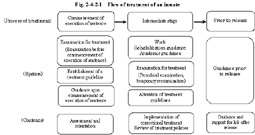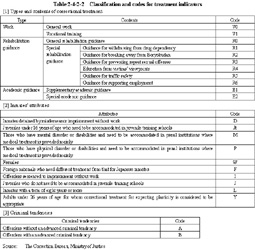| Previous Next Index Image Index Year Selection | |
|
|
1 Overview of treatment The Inmates Treatment Act was enforced and efforts have been made to improve treatment of inmates (see Part 6, Chapter 3, Section 4, 3).
Fig. 2-4-2-1 shows the flow of treatment of an inmate in a penal institution. Based on the Inmates Treatment Act, treatment of inmates aims to make inmates aware of themselves according to their individual attributes and environment, raise their motivation to rehabilitate themselves, and foster their ability to adapt to society. Correctional treatment has come to be carried out mainly through three types of activities: work, rehabilitation guidance, and academic guidance. Fig. 2-4-2-1 Flow of treatment of an inmate Correctional treatment is implemented based on a treatment guideline that specifies goals, basic contents and methods for individual inmates' correctional treatment in response to examination of their personal characteristics and environments. Inmates are to be classified into groups as needed for carrying out effective treatment. The classification for that purpose is called group classification of inmates.Establishment of treatment guidelines and group classification are based on examination for treatment carried out before commencement of execution of sentence, and on a periodical and temporary basis, utilizing expertise and technology in medicine, psychology, education, sociology, and others. Special institutions are designated as examination centers in each of the Regional Correction Headquarters, which make the detailed examinations of (i) newly imprisoned juvenile inmates under 16 years of age whose term of imprisonment is three months or more, (ii) newly imprisoned male juvenile inmates 16 years or over but under 20 years of age whose term of imprisonment is one year or more, and who have never been imprisoned before (excluding those classified into Class F), (iii) newly imprisoned male juvenile inmates 20 years or over but under 26 years of age, whose term of imprisonment is one year and half or more, and who have never been imprisoned before (excluding those classified into Class F and Boryokudan (organized crime groups) members), and (iv) those for whom examination is especially needed upon providing special rehabilitation guidance (inmates for sexual offenses, etc.). Until the Inmates Treatment Act was enforced, categories for confinement (criteria to classify a facility or division therein in which the offender is to be accommodated) and categories for treatment (criteria to classify a prior policy of treatment for the inmate) were determined based on the result of classifying examinations, and the facility for the inmate to be accommodated in was then determined mainly based on the category for confinement. Replacing former categories for confinement and categories for treatment, treatment indicators have come to be specified for respective inmates in conducting group classification. Treatment indicators are organized in terms of types and contents of correctional treatment and inmates' attributes and criminal tendencies. Facilities and prior policies of treatment suitable for respective inmates are determined based on the treatment indicators. In order to conduct appropriate correctional treatment in response to each inmate's individuality, treatment indicators are broken down in a more detailed manner than former categories for treatment. Table 2-4-2-2 shows the classification and codes for treatment indicators. Table 2-4-2-2 Classification and codes for treatment indicators |

